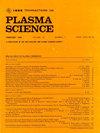Study on the Electromagnetic Scattering Characteristics of Time-Varying Dusty Plasma Target in the BGK Collision Model-TM Case
IF 1.3
4区 物理与天体物理
Q3 PHYSICS, FLUIDS & PLASMAS
引用次数: 0
Abstract
In this study, the Bhatnagar-Gross–Krook (BGK) collision model for weakly ionized dusty plasmas is obtained and the FDTD iterative equations for dusty plasma in the time-varying case is derived in combination with the Z-finite difference time domain (Z-FDTD) method (2-D TM wave). The electromagnetic (EM) scattering characteristic of a time-varying hypersonic target with a dusty plasma coating in the BGK collision model is studied by calculating the radar scattering cross section (RCS) with varying dust particle radius, dust particle concentration ratio, dusty plasma relaxation time, collision frequency, incident angle, and time-varying laws of electron density in the dusty plasma. Results show that the increase in dust particle radius and concentration, as influenced by the charging effect of dust particles, enhances the scattering of EM waves. This improvement leads to the increment in RCS. The augmented charging and collision frequencies of dusty plasma intensify the collision effect of electrons, ions, and dust particles, which decreases RCS. In addition, the effects of different incident angles and time-varying laws on the RCS are analyzed. In addition, the change in incident angle causes deviations in the overall change in RCS. Furthermore, different time-varying laws change the oscillation amplitude of RCS to some extent. These results provide theoretical support for solving the “communication blackout” problem.本研究获得了弱电离尘埃等离子体的巴特纳加-格罗斯-克罗克(BGK)碰撞模型,并结合 Z-无限差分时域(Z-FDTD)方法(2-D TM 波)推导出了时变情况下尘埃等离子体的 FDTD 迭代方程。通过计算不同尘埃粒子半径、尘埃粒子浓度比、尘埃等离子体弛豫时间、碰撞频率、入射角以及尘埃等离子体中电子密度的时变规律下的雷达散射截面(RCS),研究了在 BGK 碰撞模型中带有尘埃等离子体涂层的时变高超声速目标的电磁(EM)散射特性。结果表明,受尘埃粒子充电效应的影响,尘埃粒子半径和浓度的增加会增强电磁波的散射。这种改善导致了 RCS 的增加。尘埃等离子体的充电和碰撞频率的增加会加强电子、离子和尘埃粒子的碰撞效应,从而降低 RCS。此外,还分析了不同入射角和时变法对 RCS 的影响。此外,入射角的变化会导致 RCS 整体变化的偏差。此外,不同的时变法则也会在一定程度上改变 RCS 的振荡幅度。这些结果为解决 "通信中断 "问题提供了理论支持。
本文章由计算机程序翻译,如有差异,请以英文原文为准。
求助全文
约1分钟内获得全文
求助全文
来源期刊

IEEE Transactions on Plasma Science
物理-物理:流体与等离子体
CiteScore
3.00
自引率
20.00%
发文量
538
审稿时长
3.8 months
期刊介绍:
The scope covers all aspects of the theory and application of plasma science. It includes the following areas: magnetohydrodynamics; thermionics and plasma diodes; basic plasma phenomena; gaseous electronics; microwave/plasma interaction; electron, ion, and plasma sources; space plasmas; intense electron and ion beams; laser-plasma interactions; plasma diagnostics; plasma chemistry and processing; solid-state plasmas; plasma heating; plasma for controlled fusion research; high energy density plasmas; industrial/commercial applications of plasma physics; plasma waves and instabilities; and high power microwave and submillimeter wave generation.
 求助内容:
求助内容: 应助结果提醒方式:
应助结果提醒方式:


